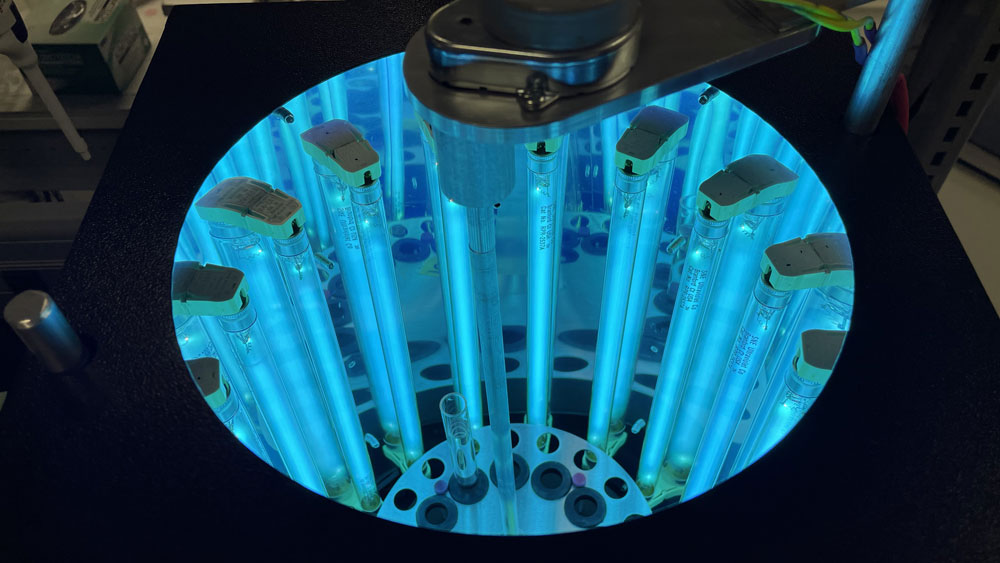
A photo reactor in the lab is used to perform controlled photochemical experiments on pollutants from lakes, rivers and streams. |
Image: Courtesy of Garrett McKay
Due to human activity, including the use of organic pollutants from pharmaceuticals and personal care products, water systems are becoming increasingly polluted. Dr. Garrett McKay, assistant professor in the Zachry Department of Civil and Environmental Engineering at Texas A&M University, received an Early Career Program grant from the U.S. Army Research Office to research the role of photochemistry (light-driven chemical reactions) on the fate of environmental pollutants in lakes, rivers and streams.
"The driving force for this research is the need to understand the mechanisms and rates by which pollutants degrade in the environment," he said.
Natural organic matter, which is present in all water bodies and comes from the decomposition of plant material, governs photochemical reactions in natural waters. Photochemical reactions convert light energy into chemical energy that can degrade pollutants.
"Our research seeks to measure the concentrations of reactive oxidants surrounding natural organic matter macromolecules, which help us better predict the importance of photochemistry to the fate of environmental pollutants," McKay said.
These photochemical reactions are also an important driver of carbon cycling in aquatic systems. Natural organic matter undergoes photochemical reactions to form carbon dioxide and carbon monoxide, which are then exported from the aquatic environment to the atmosphere.
"Because natural organic matter photochemistry is incompletely understood, uncertainties exist regarding carbon fluxes from aquatic systems, which impacts the ability to incorporate photochemistry into global climate models," he said.
Another issue relates to global climate change. A recent observation is that lake waters are "browning" due to elevated concentrations of natural organic matter due to climate change.
"The increased concentrations of natural organic material will increase the importance of photochemical degradation pathways," McKay said.
The Early Career Program aims to attract outstanding, early-career university faculty to Army-relevant research questions. It supports their research and encourages their teaching and research careers.
McKay was also recently honored by the Environmental Science & Technology journal with an Excellence in Review award, established in 2003 by the American Chemical Society to recognize multiple high-quality contributions during a single year. He has reviewed more than 50 Environmental Science & Technology papers since 2017, and his research group, the Aquatic Chemistry Lab, has recently published two articles in the journal — “Relationships Between the Physicochemical Properties of Dissolved Organic Matter and Its Reaction with Sodium Borohydride” and “Quantifying Hydrated Electron Transformation Kinetics in UV-Advanced Reduction Processes Using the Re–,UV Method.”
"The driving force for this research is the need to understand the mechanisms and rates by which pollutants degrade in the environment," he said.
Natural organic matter, which is present in all water bodies and comes from the decomposition of plant material, governs photochemical reactions in natural waters. Photochemical reactions convert light energy into chemical energy that can degrade pollutants.
"Our research seeks to measure the concentrations of reactive oxidants surrounding natural organic matter macromolecules, which help us better predict the importance of photochemistry to the fate of environmental pollutants," McKay said.
These photochemical reactions are also an important driver of carbon cycling in aquatic systems. Natural organic matter undergoes photochemical reactions to form carbon dioxide and carbon monoxide, which are then exported from the aquatic environment to the atmosphere.
"Because natural organic matter photochemistry is incompletely understood, uncertainties exist regarding carbon fluxes from aquatic systems, which impacts the ability to incorporate photochemistry into global climate models," he said.
Another issue relates to global climate change. A recent observation is that lake waters are "browning" due to elevated concentrations of natural organic matter due to climate change.
"The increased concentrations of natural organic material will increase the importance of photochemical degradation pathways," McKay said.
The Early Career Program aims to attract outstanding, early-career university faculty to Army-relevant research questions. It supports their research and encourages their teaching and research careers.
McKay was also recently honored by the Environmental Science & Technology journal with an Excellence in Review award, established in 2003 by the American Chemical Society to recognize multiple high-quality contributions during a single year. He has reviewed more than 50 Environmental Science & Technology papers since 2017, and his research group, the Aquatic Chemistry Lab, has recently published two articles in the journal — “Relationships Between the Physicochemical Properties of Dissolved Organic Matter and Its Reaction with Sodium Borohydride” and “Quantifying Hydrated Electron Transformation Kinetics in UV-Advanced Reduction Processes Using the Re–,UV Method.”